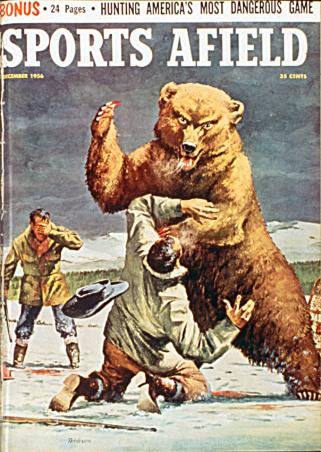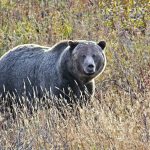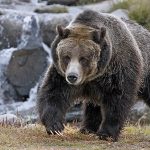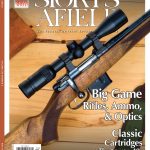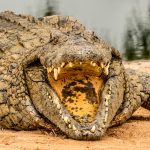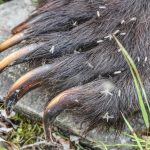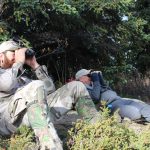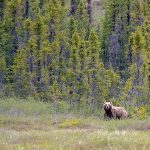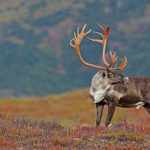What’s the best way to defend yourself if you run into a grizzly while hunting—or if a grizzly tries to run into you?
Nearly all authorities on the subject agree that the first two words to memorize in this regard are “pepper spray.” I’m fully aware that some hunters associate pepper spray with politically correct, granola-eating, New Age, tree-hugger crapola. “Just give me my gun,” these guys brag, “and I’ll drop any charging griz like a sack of rocks.”
Other hunters are less fanatical on the subject, but simply have serious (and understandable) doubts about the efficacy of a spray can to stop one of the largest and most dangerous animals in North America. Doesn’t it just make sense that a high-caliber bullet is more potent, and more effective in a life-or-death situation?
It’s a reasonable question, and by no means should hunters dismiss the power and value of their firearms, as we’ll discuss later. But as is so often the case when it comes to bears, the answer is more complex than it might first appear.
Studies by biologist Stephen Herrero and others indicate that pepper spray works on charging bears about 90 to 96 percent of the time. Mark Matheny, a hunter who was seriously mauled by a grizzly several years ago while deer hunting north of Yellowstone Park, and who subsequently began a career devoted to bear self-defense and the manufacture of UDAP pepper spray, explains how a mere blast of cayenne aerosol can stop an angry griz:
“First, with a charging bear the loud hissing and billowing cloud startles them, lessening or turning their aggressive intentions into a state of surprise or even defensive evasion. When a bear hits the wall of fog and breathes it in, his sense of smell is instantly shut down, which confuses any animal. Chemically, pepper spray is an inflammatory agent, an irritant, that gets into the bear’s mucus membranes, causing temporary blindness, choking, and difficulty breathing. In many cases, they go off hacking and coughing.”
For those who believe a gun is still a better bet to stop a bear, Matheny adds:
“Some people think a .44 magnum or large-caliber rifle is going to have the ‘power’ to stop a bear. But you’re talking about a bullet not much wider than a writing pen hitting a vital area. That’s assuming you even get a bullet off. Most times when someone with a firearm is attacked, they don’t get a shot off. You’ve got to get the gun up, aim, and fire. With pepper spray, you can fire right from the holster, putting up a wide stream, even a fog, of deterrent. You can respond instantly and the likelihood of hitting the bear is much greater.”
Another compelling reason for the use of pepper spray instead of bullets is that many grizzly charges are not full “attacks,” but are only attempts by the bear to discourage and intimidate human intruders. For instance, if you surprise a grizzly feeding on an elk carcass (possibly your elk carcass), the bear might charge without intending actual contact, its purpose being to simply drive you away.
Of course, for those who aren’t expert at reading bear behavior, it’s fair to ask, “How am I supposed to know whether the bear means business or is just bluffing?” Which is precisely why pepper spray is a better alternative to a bullet in most situations. With the spray, you can very likely discourage the bear without worsening the situation or elevating it to an irreversibly deadlier level. If the bear breaks through the spray blast, and you’re an armed hunter, you still have your gun as a last resort. But if a sprayed bear veers off, the encounter is over. No one is hurt. Conversely, if your first line of defense is a gunshot, and you shoot at the bear, the results will almost always be more severe. If the bear was only bluffing, you’ve now either killed or wounded a bear unnecessarily. Also possible is that by wounding it you’ve turned a bluffing bear into a seriously enraged one, intent on killing you. Another scenario: You shoot at an attacking bear and–because they come so fast, unbelievably fast if you’ve never experienced it, often catching you in utter surprise–you simply miss. The bear is on you. What you missed with bullets you could have easily hit with deterrent spray.
But aren’t there times when you should shoot, or perhaps must shoot? While pepper spray is generally considered the best primary, first-choice bear defense, you wouldn’t want to make the same mistake as the hunter in Wyoming’s Bridger-Teton National Forest who, when charged by a sow grizzly with three yearling cubs, allegedly threw his high-powered rifle at the bear and pulled out a can of pepper spray, which by that time failed to stop the attack. The hunter was mauled until his partner shot and killed the 475-pound animal. Later, from his hospital bed, the hunter said he didn’t want to shoot the bear because he feared going to jail (for killing an endangered species) and losing his hunting privileges.
The reality is, if a grizzly attacks, sometimes you have to shoot, and, further, you would be foolish not to. That is why I think of pepper spray as “the first line of defense, when feasible.” If there’s no time to hit the spray button (and with the canister mounted pistol-fashion on your belt, you can aim and fire from the hip in mere seconds), or if you spray and the bear keeps coming, you have little choice but to shoot. With a grizzly still far enough away to dissuade, you can try a shot into the air or into the ground near the animal, hoping the muzzle blast or bullet noise will stop or turn the charge. But with a close, fast-incoming bear, don’t waste time with a warning shot. Aim for the deadliest point you can find. On a close-in, charging bear, this will probably be the face or upper chest. Often full-attack grizzlies lower their heads as they come in, so that’s about all you have to aim at. More than one Alaskan guide of my acquaintance suggests aiming for the snout–a high shot goes into the upper skull or even over the top, into the neck or spine; and if the bear hops or you shoot low, you have a chance at the throat, chest, or even a shoulder or leg, all of which can stop the animal, if only long enough for you to aim and shoot again.
Although this is legitimate self-defense, it clearly is not a desirable outcome. That is why Mark Matheny likes to tell hunters, “Spray ’em, don’t slay ’em.” He points out that too many close-encounter grizzlies are killed unnecessarily; which is not only bad for the bears, but also for hunting’s already precarious social image. Long-time bear biologist Chris Servheen agrees, calling the unnecessary killing of grizzlies by sportsmen nothing less than “a threat to hunting.”
In the end, the ideal is to protect yourself while sparing the bears, whenever that’s possible.
